.jpg?width=800&height=460&name=iStock-595761688%20(1).jpg)
Philanthropy has enjoyed loads of benefits from the rapid development of grants management technology, making processes more streamlined and and the ability to make better informed decisions much easier. But new tech brings new challenges. Once you determine the right software for your needs, you still must implement it to reap the benefits. This can be a stressful project to take on for anyone – tech-savvy or not.
It can be stressful, but it doesn’t have to be debilitating.
Change – especially change brought about by a sizable technology implementation – affects every person and every organization differently. Lack of expertise, time, or an in-depth awareness of your technological requirements can all hamstring a tech implementation before it even starts. Also a debilitating fear of change or the all-too-common pitfall of losing your focus can doom your project. But don’t let these challenges stop you.
5 Keys to A Seamless Implementation
Implementing new grants management software can be an exciting transition for your team, but it’s up to your team to rise above and approach the process intentionally. Taking these five tips into consideration will make your implementation process as smooth as possible:
Master the Art of Change Management
Before you take any action, reflect on how change affects your organization. After all, your organization is made up of people, and people don’t always relish change. Whether it’s fear of technology or fear of failure, change can create an atmosphere that can doom your project from the start.
For a closer look at best practices in change management, see our whitepaper: The Grants Management Software Implementation playbook: 5 Tips for Surefire Success.
Grantmaker, Know Thyself
Believe it or not, implementing technology provides a great opportunity for self-discovery. In fact, the more you know about your team, your processes, and your data, the smoother the implementation will go. It may even present a chance to improve upon your current grantmaking practices.
Create Your Technology Roll-out Plan
Thorough planning will save you from spending all its time putting out fires. As you onboard a new grants management system, there are several tactics that will ease the strain on everyone involved: Set realistic timelines, create a training plan, develop a communications plan, and build out a long-term plan for maintaining data quality.
For more information on developing a top-notch technology roll-out plan, see our whitepaper: The Grants Management Software Implementation playbook: 5 Tips for Surefire Success.
After Initial Training Comes Long-Term Training
Training shouldn’t end after the standard end user training is over. Continued success is reliant on creating a training plan with a long-term vision in mind. The best cases of technology adoption are the result of training that is role-based and shows value to each user.
Keep the Team Accountable
Don’t forget that accountability is a two-way street. Your internal team members should be aware of milestones and have realistic goals set for any tasks they need to achieve, from the preparation phase through onboarding and training. Additionally, you should hold the vendor’s team accountable to the time frame set forth at the beginning of the project.
You don’t have to suffer from implementation-caused anxiety, and you certainly shouldn’t shy away from seeking out the precise technology your organization needs simply because implementation takes time and effort.
Proper planning, clear communication among stakeholders, and a focused long-term outlook can guard foundations against debilitating stress and ensure a smooth transition to better technology.
